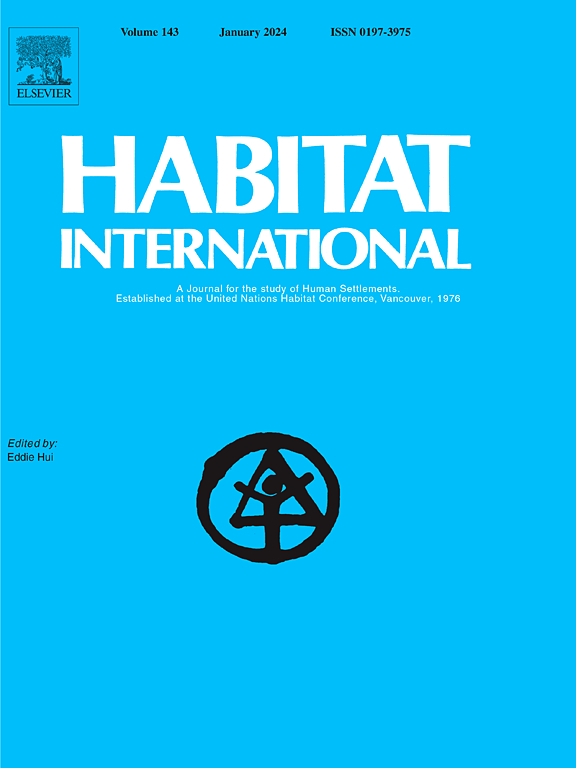Displaced by nature, driven by choice: Exploring the factors influencing environmental migrants' habitat preferences in coastal Bangladesh
IF 6.5
1区 经济学
Q1 DEVELOPMENT STUDIES
引用次数: 0
Abstract
This study examines the factors influencing environmental migrants’ habitat preferences in southwestern Bangladesh. Using a multi-stage sampling technique, we selected 408 households in rural and urban areas, who had moved to their current locations due to climatic extremes. We applied relevant regression models to analyze the complex interplay of socioeconomic, environmental, and institutional factors shaping migration decisions. Our empirical results suggest that, despite having greater access to services in cities, migrants reported lower levels of well-being than their rural counterparts, which could be attributed to reduced social cohesion and limited opportunities for participation in decision-making. Disaster preparedness, early warning access, and prolonged exposure to environmental hazards significantly influence migration decisions and well-being. Protracted post-disaster suffering increases the likelihood of migration to urban slums, emphasizing the vulnerability of rural populations. Men are more likely than women to migrate to urban areas, possibly due to perceived employment opportunities. Surprisingly, while slum dwellers have better service access, their well-being scores are lower than rural residents. Access to education, healthcare, safe drinking water, and early warning systems are all crucial determinants of well-being. Policy recommendations include improving disaster preparedness and early warning systems in rural areas, developing targeted interventions for urban slum migrants focused on social cohesion and income diversification, and implementing gender-specific support programs. This research contributes to understanding environmental migration dynamics in Bangladesh and informs policymakers about sustainable resettlement strategies. Future studies should explore non-linear relationships and expand to diverse geographical contexts.
因自然而迁移,因选择而迁移:探索影响孟加拉国沿海环境移民栖息地偏好的因素
本研究探讨了影响孟加拉国西南部环境移民栖息地偏好的因素。我们采用多阶段抽样技术,在农村和城市地区选取了 408 户因极端气候而迁往现居住地的家庭。我们运用相关回归模型分析了影响迁移决策的社会经济、环境和制度因素的复杂相互作用。我们的实证结果表明,尽管移民在城市能获得更多服务,但他们的福利水平却低于农村移民,这可能是由于社会凝聚力下降和参与决策的机会有限造成的。备灾、获得早期预警以及长期暴露于环境危害中都会对移民的决定和福祉产生重大影响。长期的灾后苦难增加了向城市贫民窟迁移的可能性,凸显了农村人口的脆弱性。男性比女性更有可能迁移到城市地区,这可能是由于他们认为有就业机会。令人惊讶的是,虽然贫民窟居民能获得更好的服务,但他们的幸福指数却低于农村居民。获得教育、医疗保健、安全饮用水和预警系统都是幸福感的重要决定因素。政策建议包括改善农村地区的备灾和预警系统,为城市贫民窟移民制定有针对性的干预措施,重点关注社会凝聚力和收入多样化,以及实施针对不同性别的支持计划。这项研究有助于了解孟加拉国的环境移民动态,并为政策制定者提供有关可持续移民安置战略的信息。未来的研究应探索非线性关系,并扩展到不同的地理环境。
本文章由计算机程序翻译,如有差异,请以英文原文为准。
求助全文
约1分钟内获得全文
求助全文
来源期刊

Habitat International
Multiple-
CiteScore
10.50
自引率
10.30%
发文量
151
审稿时长
38 days
期刊介绍:
Habitat International is dedicated to the study of urban and rural human settlements: their planning, design, production and management. Its main focus is on urbanisation in its broadest sense in the developing world. However, increasingly the interrelationships and linkages between cities and towns in the developing and developed worlds are becoming apparent and solutions to the problems that result are urgently required. The economic, social, technological and political systems of the world are intertwined and changes in one region almost always affect other regions.
 求助内容:
求助内容: 应助结果提醒方式:
应助结果提醒方式:


